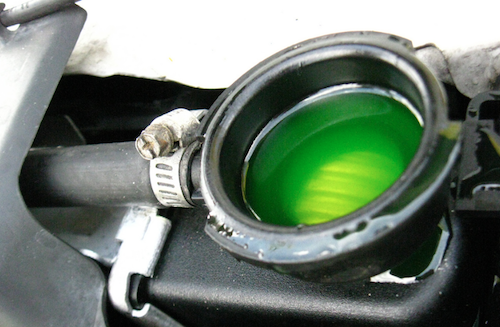

Your cooling system is designed to keep your vehicle from overheating and also protects certain engine parts from corrosion. When the cooling system isn’t able to do its job, because the coolant is old or the belts and hoses are wearing out, the engine is at risk of overheating. When that happens, serious engine damage can occur. Learn about the 4 signs you may have a cooling system problem and what you can do to keep it running optimally.
Before identifying the problem signs, let’s go through how the cooling system works. It’s a circular system that takes the antifreeze (also known as coolant) and moves it through passages in the engine block and heads. As the coolant flows through these passages, it picks up heat from the engine and then flows back out to the radiator where it is cooled by the air that passes through the grill. The water pump is responsible for making sure the fluid keeps moving through the system and the thermostat controls the temperature of the coolant. If any one of these parts doesn’t work properly, the engine will run hotter and will eventually overheat.
Here are the four signs that the cooling system isn’t working properly:
- The engine overheats. As mentioned above, this can occur because of a failure of any of the parts that make up the cooling system. When this occurs, a “red” water temperature warning light will come on. Do not ignore an overheating engine. In fact, you will want to immediately and safely pull over, stop your vehicle and call for a tow. If you continue to drive, you will risk major engine damage.
- You can smell antifreeze. If you can smell antifreeze while you are driving or when the engine is still hot after driving, there is most likely a leak in the system. It could be coming from a leaking hose, a leak in the radiator or from leaks in the water pump or thermostat housing. Have your vehicle checked right away so any leaks can be located and fixed.
- You notice coolant under the front of your vehicle. Coolant leaks can be yellowish-green, pastel blue or fluorescent orange (depending on the type of antifreeze used in your vehicle). Schedule an appointment to have the cooling system checked right away.
- You find you have to add coolant to the radiator on a regular basis.
Maintaining the Cooling System is Simple
- Once a month, check the radiator, belts and hoses to make sure they don’t show signs of aging, cracks, dryness, bulging, etc. If they do, have them replaced.
- Have the drive belt (also known as the serpentine belt) replaced before it breaks. The owner’s manual will let you know when it needs to be replaced, and if you have your vehicle regularly maintained at Luke’s Auto Service in Verona, NJ, our technicians will keep an eye on it for you.
- Have the cooling system flushed and the fluid replaced every two years. Don’t remember when the cooling system was last flushed? We can perform a test to see if the coolant can adequately protect the vital engine components.
The simplest way to care for your vehicle’s cooling system is to bring it to our auto repair shop located in Verona, New Jersey, where we can handle all of your auto maintenance and repair issues. Schedule your cooling system maintenance today.
